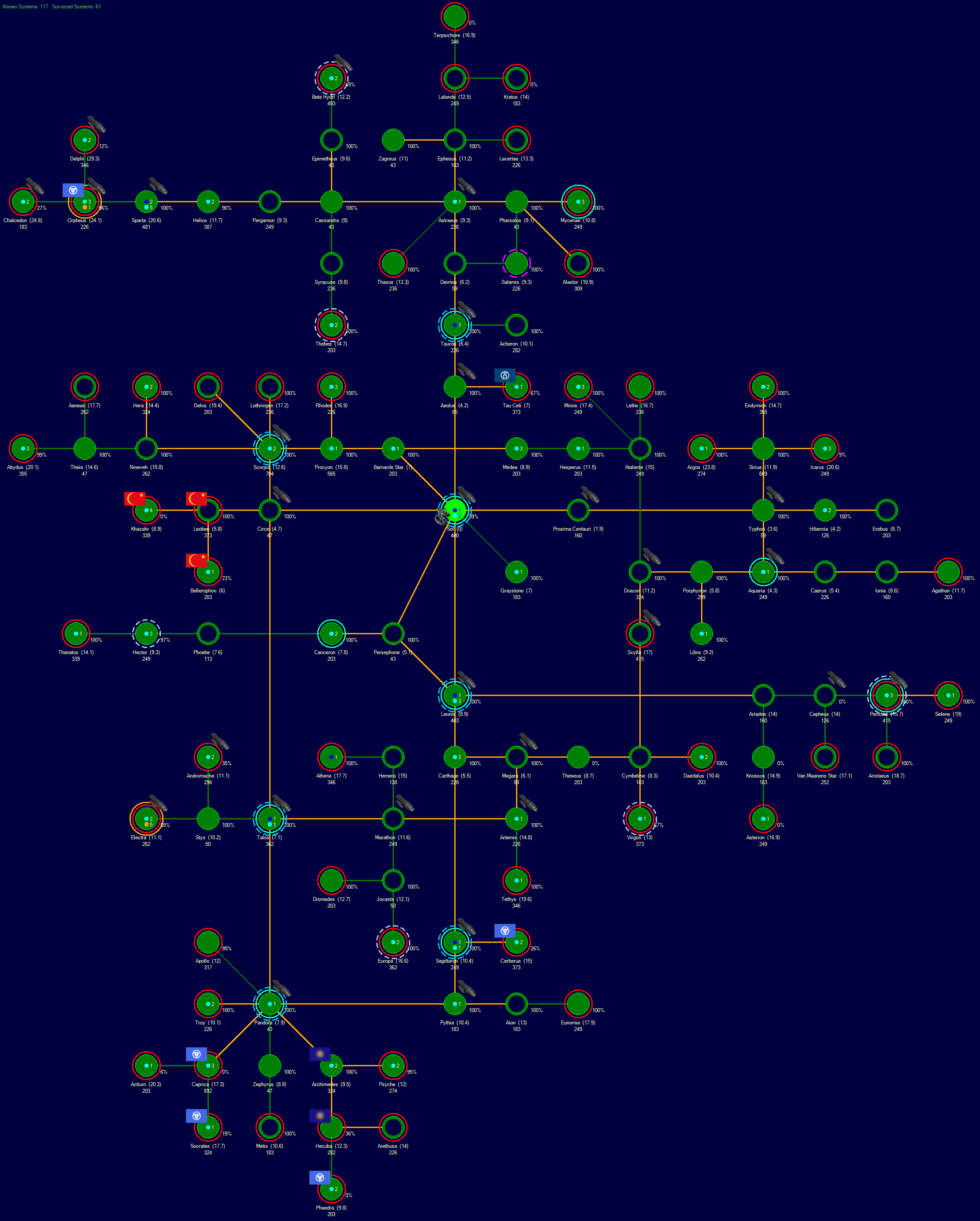In November 2306, a Raptor-G from the Battlestar Fenrir explored a second jump point in Pandora and discovered Caprica, a system with a white A0-V star three times the mass of Sol and eighty times the luminosity, orbited by twelve planets and a hundred moons. The fourth, fifth and sixth planets all had nitrogen – oxygen atmospheres. Caprica IV was an Earth-sized ocean world with gravity of 1.03G, an atmosphere of 1.09 atm, including 0.12 atm of oxygen, minimal eccentricity and a surface temperature of 30C. The removal of 0.02 atm of sulphur dioxide would make this an ideal habitable world.
Caprica V was a cold, Mars-sized world at -47C, dominated by Taiga and with a quarter of its surface covered in ice sheets. The atmosphere of 0.51 atm included 0.092 atm of oxygen and was close to breathable. However, the planet was at its farthest distance from the primary and with an eccentricity of 0.18 it would reach 9C at perihelion. It was an excellent terraforming prospect, although the temperature range meant that a small of amount of infrastructure would always be required. Caprica VI was similar to Caprica V in terms of surface ice and environmental conditions, although the atmosphere was only 0.186 atm.
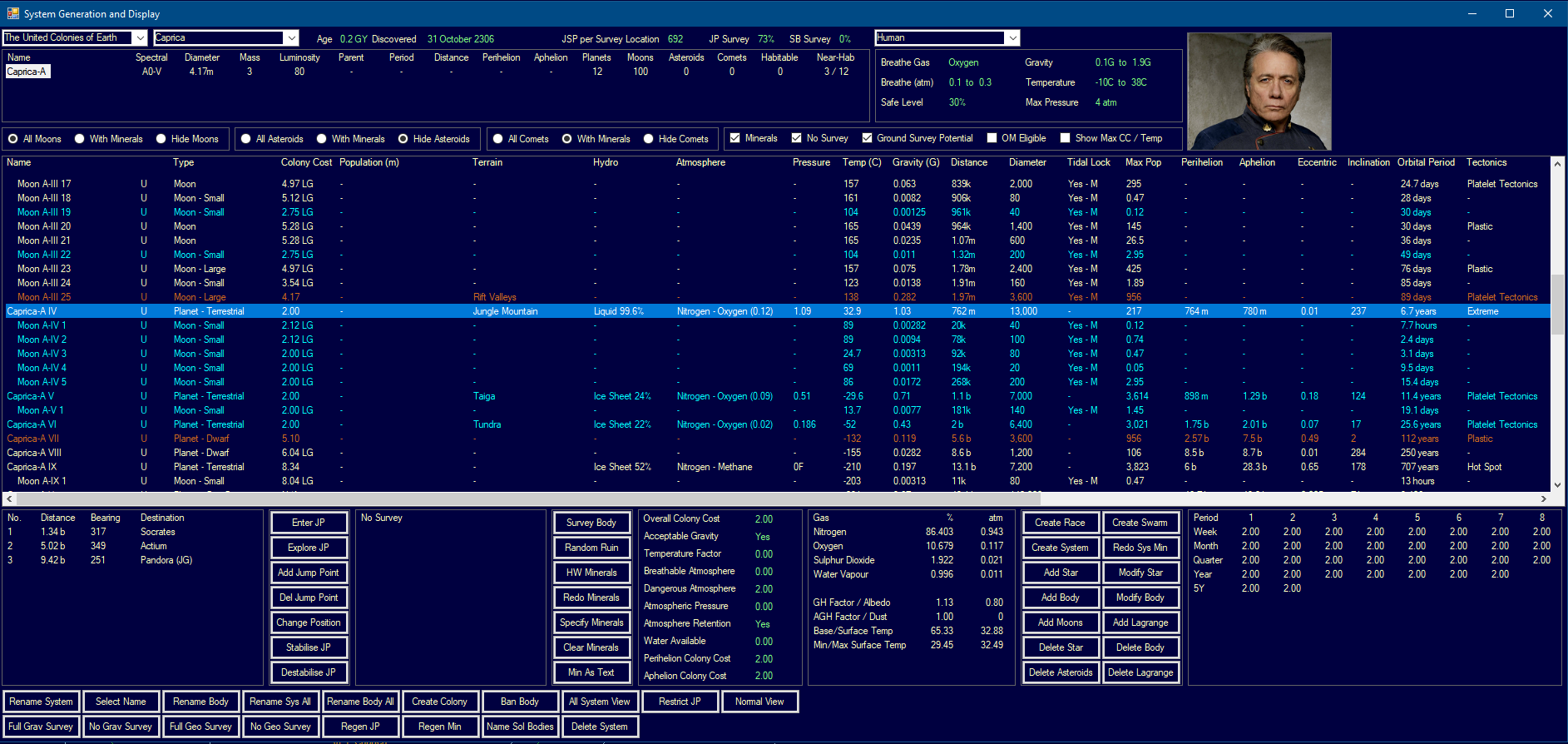
Shortly after the discovery of Caprica, full communication with the aliens that were first encountered in Pandora was established. They identified themselves as the Kogari Dominion. The Kogari were shorter than humans and hunched forward as if they could switch between bipedal and quadrupedal as desired. Their heads were elongated and vaguely raptor-like, although their facial features were unknown apart from eyes on either side of their heads because they wore close-fitting armour with several odd protuberances. Apart from the initial contact, the Kogari were brief in their communications and seemed content to mostly ignore the Colonial ships.
The location of the Kogari Dominion home world was unknown, but identifying that location was the first priority of Survey Command. A potential candidate in the Troy system, adjacent to Pandora, had been ruled out so the focus changed to Caprica. The Raptor-G from Fenrir that discovered the system headed for the fourth planet, the closest of the potentially inhabited worlds. As it approached, it detected inbound missiles and was destroyed shortly thereafter. A scout Raptor was sent into the system to identify the assailants and detected six ships from the Cerberus aliens, now commonly referred to simply as the Cerberus by Colonial personnel, in orbit of Cerberus IV. All six ships were of different classes, with three approximately 17,500 tons and the others 8800. Moments later, two more ships of another new class were detected but only from their sensor emissions, which suggested they were smaller than the Raptor’s sensor resolution. As the scout turned for the jump point, it was destroyed by a dozen missiles with strength-6 warheads.
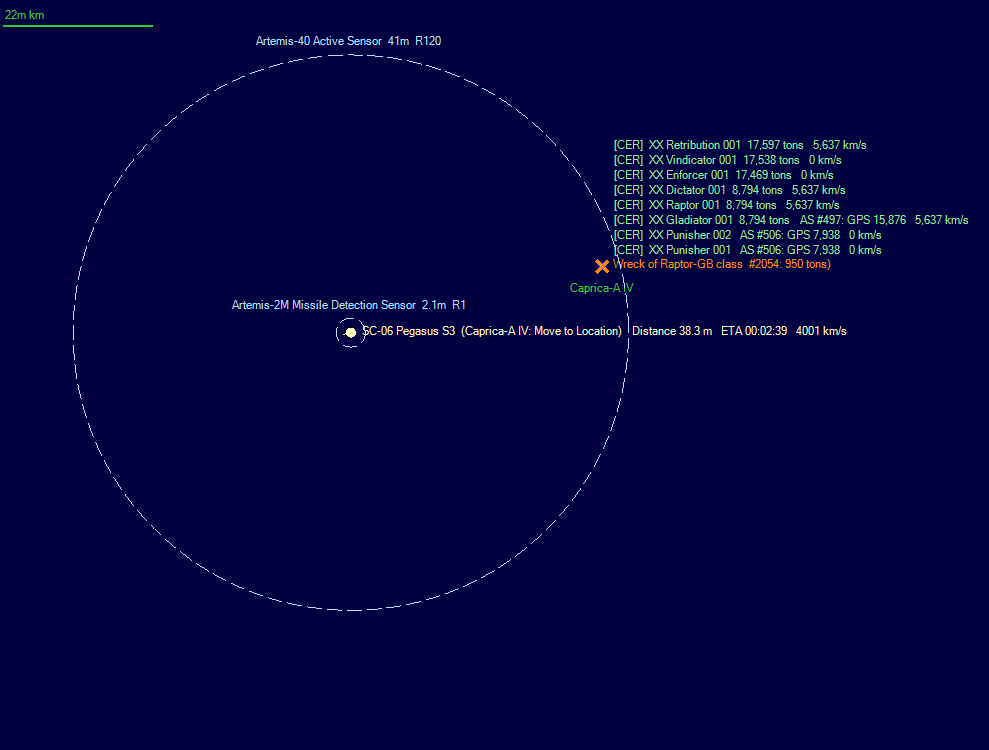
The gravitational survey of Pandora was completed in mid-December. Six jump points were discovered in total, including the entry point from Pythia and the two already explored jump points that led to Troy and Caprica. The other three led to Apollo, Archimedes and Zephyrus. The latter was an unremarkable brown dwarf system. Apollo had an K6-V primary and four planets, one of which had a breathable atmosphere and was completely covered by an ice sheet. The temperature of -87C made it an unlikely home world candidate and a geological survey confirmed it was devoid of both Kogari colonies and mineral deposits.
Archimedes was an unremarkable collection of planets, moons and asteroids, but was notable for two reasons. The first was Archimedes II, a large terrestrial world with an atmosphere of nitrogen and CO2, that had over eighty million tons of accessibility 1.0 Duranium, along with five other deposits at minimal accessibility. The second was a stabilised jump point to Pandora, which suggested that the Kogari home world could lie somewhere beyond Archimedes. On March 1st 2307, that theory was reinforced by a new class of Kogari ship entering Pandora from Archimedes.
Archimedes-A II Survey ReportDuranium: 81,510,912 1.00
Corbomite: 26,708,224 0.20
Tritanium: 34,245,904 0.20
Mercassium: 3,326,976 0.10
Corundium: 5,914,624 0.10
Gallicite: 49,956,624 0.10
Given the number of jump points in Pandora, the presence of the Kogari Dominion somewhere beyond it and the fact it lay at the end of a jump chain that included the key colonies of Sagittaron and Leonis, the Council of Twelve decided to establish a new colony and military base in the system. The system primary was a brown dwarf, orbited by two planets. Pandora I was a tide-locked dwarf planet with a gravity of 0.11G, a surface temperature of -195C and no atmosphere or water. Even so, it was the best option. Pandora II was a gas giant with forty-eight moons, all of which were colder than Pandora I and lacked the more temperate zone provided by tide-locking. The first infrastructure and colonists arrived on April 1st 2307.
Meanwhile, an investigation of another alien race was underway in the Talos system, six transits from Sol via Leonis, Carthage, Megara, Artemis and Marathon. Talos I was an Earth-like planet where a survey Raptor had detected a ground forces contact but did not have the necessary passive sensors to detect a population. In December 2306, a scout Raptor arrived in orbit of the planet and detected a population with a thermal signature of 4,440 and an EM signature of 44,400. Such a wide disparity suggested a large population but no installations. Given the absence of any ships or orbital infrastructure, it was potentially a pre-industrial civilization.
In January 2307, an Armistice class diplomatic station was towed to Talos but there was no response to communication attempts, perhaps because the population lacked the technology to receive the message. While the diplomatic efforts were underway, the geological survey of Talos I was completed, revealing accessible deposits of all eleven minerals, including over a million tons of accessibility 1.0 Duranium.
Talos I Survey ReportDuranium: 1,164,600 1.00
Neutronium: 203,400 0.90
Corbomite: 261,600 1.00
Tritanium: 527,700 0.70
Boronide: 219,000 0.70
Mercassium: 462,600 1.00
Vendarite: 440,700 0.70
Sorium: 1,183,050 0.60
Uridium: 241,500 0.40
Corundium: 234,900 0.50
Gallicite: 297,900 0.60
On the military front, all Valkyrie class Battlestars had been updated to the Valkyrie II design and a ninth unit of the class, Baldur, had been completed. The Valkyrie II had faster-firing railguns, an increase in armour thickness and new engines. The original design had slow but efficient gas core engines, but the new ZDS-750 Ion Drives were the same model used for the Galactica II class. This resulted in a substantial reduction in range but the deployment time was only reduced from thirty-six to thirty months as the Valkyrie II was intended for both survey duties and frontier deployments. Five of the Valkyrie IIs were operating with survey Raptors and four with combat strikegroups.
Valkyrie II class Battlestar 37,500 tons 743 Crew 5,014.3 BP TCS 750 TH 3,000 EM 0
4000 km/s Armour 5-99 Shields 0-0 HTK 210 Sensors 12/12/0/0 DCR 33 PPV 60.64
Maint Life 2.55 Years MSP 2,762 AFR 341% IFR 4.7% 1YR 594 5YR 8,914 Max Repair 375 MSP
Hangar Deck Capacity 12,000 tons
Colonel Control Rating 3 BRG AUX ENG
Intended Deployment Time: 30 months Flight Crew Berths 240 Morale Check Required
Zeus Drive Systems ZDS-750 Ion Drive (4) Power 3000 Fuel Use 24.49% Signature 750 Explosion 10%
Fuel Capacity 1,477,000 Litres Range 28.9 billion km (83 days at full power)
Ares Kinetics AK-20B Railgun (4x4) Range 160,000km TS: 4,000 km/s Power 12-4 RM 40,000 km ROF 15
Ares Kinetics G20-8 Gauss Cannon Turret (2x8) Range 20,000km TS: 16000 km/s RM 20,000 km ROF 5
Hyperion R256-S4 Beam Fire Control (1) Max Range: 256,000 km TS: 4,000 km/s
Hyperion R64-S16 Beam Fire Control (1) Max Range: 64,000 km TS: 16,000 km/s
R-8 Magnetic Mirror Fusion Reactor (2) Total Power Output 16.6 Exp 5%
Artemis-60 Active Sensor (1) GPS 10080 Range 62.5m km Resolution 120
Artemis-5M Missile Detection Sensor (1) GPS 12 Range 4.8m km MCR 430.9k km Resolution 1
Themis EM-12 Passive Sensor (1) Sensitivity 12 Detect Sig Strength 1000: 27.4m km
Themis TH-12 Passive Sensor (1) Sensitivity 12 Detect Sig Strength 1000: 27.4m km
Survey Group
15x Viper MK II Fighter Speed: 10001 km/s Size: 6
1x Raptor-T Tanker Speed: 3201 km/s Size: 19.99
1x Cobra MK I Fighter Speed: 7504 km/s Size: 11.99
3x Raptor-GB Geological Survey Craft Speed: 2801 km/s Size: 19.99
3x Raptor-RB Gravitational Survey Craft Speed: 2801 km/s Size: 19.99
In September 2307, an exploration of a newly discovered jump point in Talos revealed a dormant jump point in Circe, a system adjacent to Sol that was also the contact point with the Church of Khazhar. Neither the Twelve Colonies nor the Khazhari had claimed Circe, as it was a planetless brown dwarf, which meant the Khazhari had an open path to the presumed pre-industrial race in Talos. However, the new jump point was three hundred million kilometres from the from other jump points in Circe so it was possible the Khazhari would not detect it via monitoring Colonial traffic. Even so, the Council of Twelve ordered a new colony on Talos I to provide a claim on the system. The freighters and colony ships would use the Circe route as it was much shorter than the original route of six transits.
In Pandora, a group of three Kogari Dominion ships were detected entering from the Archimedes jump point and taking up station on the Troy jump point. The largest was a 68,000-ton commercial-engined vessel with a strength-1600 thermal signature that was designated as Djinn class. It was escorted by two ships of 17,300 tons designated as Gryphon and Wyvern classes. Colonial Intelligence believed this was a stabilisation ship and escorts and its origin point in Archimedes gave further credence to the theory that Archimedes was the route to the Kogari home world.
In November 2307, two squadrons of Viper MK Is and a new space station designated as a Fighter Base class were deployed to the rapidly-growing Pandora colony, which had a population of just under two million.
Fighter Base class Space Station 29,141 tons 298 Crew 734.2 BP TCS 583 TH 0 EM 0
1 km/s No Armour Shields 0-0 HTK 49 Sensors 6/6/0/0 DCR 1 PPV 0
MSP 2,515 Max Repair 100 MSP
Cargo Shuttle Multiplier 1
Captain Control Rating 1 BRG
Intended Deployment Time: 3 months
Maintenance Modules: 5 module(s) capable of supporting ships of 10,000 tons
Fuel Capacity 2,000,000 Litres Range N/A
Refuelling Capability: 50,000 litres per hour Complete Refuel 40 hours
Artemis-20N Navigation Sensor (1) GPS 1440 Range 23.6m km Resolution 120
Themis EM-6 Passive Sensor (1) Sensitivity 6 Detect Sig Strength 1000: 19.4m km
Themis TH-6 Passive Sensor (1) Sensitivity 6 Detect Sig Strength 1000: 19.4m km
After the destruction of the Battlestar Jormungandr in 2304, her three surviving Raptors, all gravitational survey craft, remained in service, operating from the colonies of Leonis and Sagittaron and contributing to the exploration of the systems beyond Pandora’s five outward jump points. Their main focus was on Archimedes. Two outward jump points were discovered, leading to Psyche and Hecuba, neither of which contained any habitable planets. A subsequent survey of Hecuba revealed a further two jump points, connecting to Arethusa, a planetless red dwarf, and Phaedra, which a Jormungandr Raptor probed on December 3rd 2307. The system itself was unremarkable, a red dwarf with six planets, the first of which was a super-terrestrial world with a dense nitrogen-ammonia atmosphere.
Of far more interest was the wreckage of twenty ships, most near the Hecuba jump point but a few near the centre of the system. Thirteen were known Dominion classes, a Djinn stabilisation ship, three Sphinx class scouts and nine 17,300-ton wrecks of the Gryphon and Wyvern classes. The other seven were unknown, but seemed to comprise three different sizes between 8650 tons and 17,600 tons. The Raptor transited back into Hecuba, from where it could report the wrecks via the stable jump network, then returned to Phaedra to begin a survey. Two Colonial salvage ships were immediately dispatched from Sol to Pandora, along with two freighters and the Battlestar Ragnarok as escort. Two Galactica class Battlestars were already forward deployed at Sagittaron in response to the original encounter with the Kogari Dominion so these could be used to escort a mission into Phaedra if necessary, although for the moment there was no stabilised jump point on the Phaedra side.
By April 2308, two further jump points had been discovered in Talos. The first led to Styx, an unremarkable brown dwarf system. The second complicated the galactic map considerably by connecting to a dormant jump point in Pandora. While this new connection shortened the distance to Pandora, as ships could move from Sol via Circe and Talos, it brought the Kogari Dominion within a single transit of the pre-industrial population on Talos I, which was already facing a potential threat from the Church of Khazhar. The two alien races were now just two transits apart and could potentially meet in Talos if each discovered the new jump points in Circe and Pandora.
By this point, the colony in Pandora had a population of two point seven million and the Talos colony was at one point seven million. No territorial claims had been made by any side. The Council of Twelve was concerned that Talos could provide the spark for conflict between the Twelve Colonies and either the Kogari Dominion or the Church of Khazhar, or potentially between the two alien races, as each strove to exploit the mineral deposits and large alien population on Talos I. Therefore, the Council gave the order to secure the alien population once sufficient ground forces were in place.
A Raptor-S scout, en route to Phaedra to conduct a sweep of the inner system, encountered a large Kogari fleet stationed on the Archimedes – Hecuba jump point, comprising two Gryphons, two Wyverns and eight of a new 56,000-ton Basilisk class. Fleet is on Hecuba jump point. The scout travelled across Hecuba and transited into Phaedra, where it detected the wreck of the Jormungandr Raptor and four ships of the Cerberus close to the jump point; a Retribution of 17,600 tons and three different classes at 8800-tons. The scout narrowly escaped a subsequent missile attack and took up station on the Hecuba – Phaedra jump point. This was the third system in which the Cerberus aliens have been detected.
Two weeks later, a fleet of Kogari warships arrived at the Hecuba – Phaedra jump point, comprising a Wyvern, three Gryphon, four Orcs and two of a new type designated as Dragon class. A few days after their arrival, the Kogari politely asked the scout to leave Hecuba as it was within their territory. This was the first real confirmation that the Dominion home world lay somewhere beyond the Pandora – Archimedes jump point. The Raptor-S retreated into Archimedes, but a few days later was asked to leave that system too. The territory claimed by the Kogari Dominion was now just one transit from the Pandora colony.
On April 19th 2308, the first twelve Raptor-A class Corvettes were launched from Cepheus Shipyard in Earth orbit. The Raptor-A was an experimental design with eighteen box launchers, providing the Colonial Fleet with a limited missile capability. The Theseus Anti-ship Missile had a range of thirteen million kilometres, which was far less than the demonstrated range of Cerberus missiles, and a speed of 31,250 km/s. The performance of the Raptor-A in combat would determine the level of further investment in missile technology.
Raptor-A class Corvette 1,000 tons 10 Crew 142.5 BP TCS 20 TH 150 EM 0
7503 km/s Armour 1-8 Shields 0-0 HTK 3 Sensors 0/0/0/0 DCR 0 PPV 10.8
Maint Life 3.44 Years MSP 47 AFR 32% IFR 0.4% 1YR 6 5YR 91 Max Repair 75 MSP
Magazine 72
Captain Control Rating 1
Intended Deployment Time: 1 month Morale Check Required
Zeus Drive Systems ZDS-150B Ion Drive (1) Power 150 Fuel Use 438.18% Signature 150 Explosion 20%
Fuel Capacity 65,000 Litres Range 2.7 billion km (4 days at full power)
Missile Box Launcher (18) Missile Size: 4 Hangar Reload 100 minutes MF Reload 16 hours
Graystone GFC-20B Missile Fire Control (1) Range 19.9m km Resolution 120
Theseus Anti-ship Missile (18) Speed: 31,250 km/s Range: 13.4m km WH: 6 Size: 4 TH: 104/62/31
Artemis-17B Active Sensor (1) GPS 576 Range 17.2m km Resolution 120
In May 2308, the Colonial Fleet began an operation to secure Talos I, commonly referred to as Talos Prime. The primary goal was to protect the alien population from any interference by the Kogari Dominion or the Church of Khazhar. Nine Colonial Marine regiments were in place, out of a total of twenty-two, all of which had three Colonial Marine battalions and seven of which had their attached Planetary Defence battalions. The alien ground forces numbered in the tens of thousands but were only equipped with very primitive weapons, similar to 18th century muskets. They attempted to fight, but the battle was a complete rout. After three days of conflict, the alien population ceased all resistance.
Communication was established shortly thereafter. The inhabitants were long-necked humanoid amphibians with large black eyes and their total population was close to nine hundred million. The name of their species was unpronounceable for humans, so they became known as the Talosians. There was considerable resentment following the invasion, especially as the Talosians considered themselves to be great warriors, but civilian casualties had been minimal and the population would soon benefit from a much higher level of technology. The Council of Twelve believed that they would be assimilated into the Twelve Colonies within a few years.
On June 19th 2308, an Abadan class scout from the Church of Khazhar entered Talos via the Circe jump point, apparently having detected the new jump point by monitoring Colonial shipping traffic. The ship was asked to leave as the Twelve Colonies now claimed the Talos system. Within a few days, the Khazhari accepted the Colonial claim and left Talos. Two weeks later, the Kogari Dominion was asked to vacate Pandora as it was the site of a significant Colonial population of three point six million. The Kogari accepted Colonial sovereignty and departed the system shortly thereafter. The key systems of Talos and Pandora were now secure for the moment, although fleet elements would be assigned to both systems.
In early July, the first major naval combat operation since the Commonality War began in Sagittaron. With the increasing number of known alien races, and the associated geopolitical complexities, the Council of Twelve wished to decrease the number of actual and potential threats. As the recent agreements with the Kogari Dominion and the Church of Khazhar had secured the frontiers, at least for the moment, an expeditionary force of four Galactica class Battlestars was ordered to launch an operation into Cerberus to attack the alien force that destroyed the Battlestar Jormungandr. This would eliminate a threat adjacent to the Sagittaron colony and the key jump chain on which it was located. The Battlestars were accompanied by both Hermes class fighter transports, each carrying four missile-armed Raptor-As and a pair of Asp scout fighters.
Expeditionary ForceGalactica II class Battlestar:
Ares, Athena, Atlantia, ColumbiaHermes class Fighter Transport:
Hermes, Maia8x Raptor-A class Corvette
8x Raptor-MB class Assault Transport
2x Raptor-SB class Scout
2x Raptor-SC class Scout
20x Cobra MK II class Fighter
240x Viper MK II class Fighter
4x Asp MK I class Fighter
Asp MK I class Fighter 200 tons 1 Crew 50.4 BP TCS 4 TH 60 EM 0
15021 km/s Armour 1-3 Shields 0-0 HTK 2 Sensors 0/0/0/0 DCR 0 PPV 0
Maint Life 2.36 Years MSP 25 AFR 40% IFR 0.6% 1YR 6 5YR 92 Max Repair 30 MSP
Captain Control Rating 1
Intended Deployment Time: 0.9 days Morale Check Required
Zeus Drive Systems ZDS-60B Ion Drive (1) Power 60 Fuel Use 692.82% Signature 60 Explosion 20%
Fuel Capacity 10,000 Litres Range 1.3 billion km (24 hours at full power)
Artemis-30NB Navigation Sensor (1) GPS 1920 Range 31.5m km Resolution 120
The Expeditionary Fleet moved to a position four hundred and eight million kilometres from Cerberus-B, a K4-V star with four planets, and dispatched an Asp fighter to sweep inner system. Just over thirty million kilometres from Cerberus-B II, the Asp detected a large alien fleet. The five 8800-ton ships that attacked Jormungandr, two Avengers and three Reapers, were all present, but they were accompanied by five new ships; three 26,400-ton Annihilators and two 17,600-ton Conquerors. The alien fleet was moving at 5636 km/s.
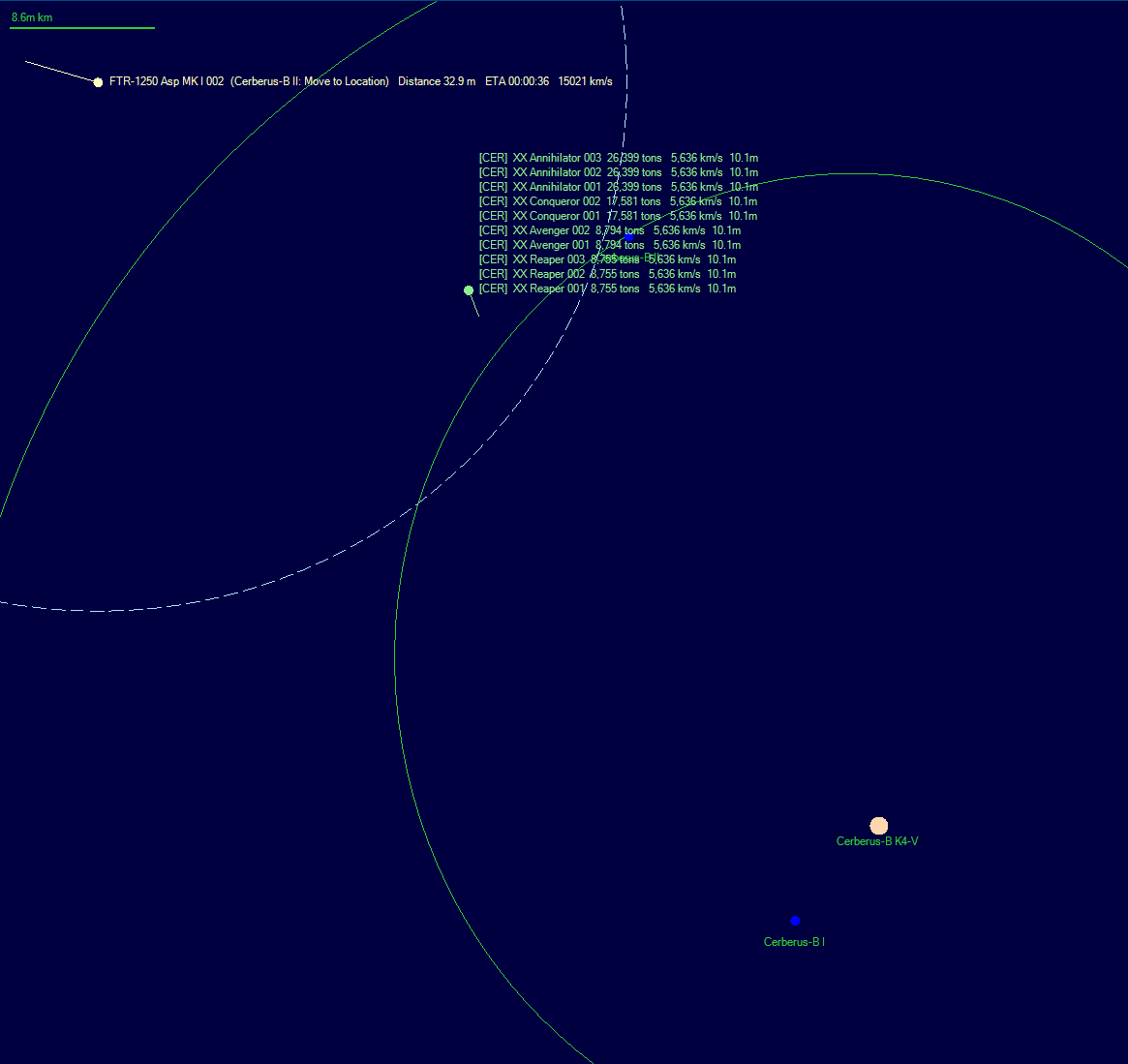
The Expeditionary Force was led by Commander Leto Medea of the Battlestar Columbia, a veteran of the Battle of Uranus. He ordered the Asp to shadow the alien fleet at a distance of twenty-five million kilometres, then launched a second Asp to swing around it and investigate Cerberus-B III, which had been deemed the most likely origin point due to its thin nitrogen-oxygen atmosphere and limited surface water. The alien warships pursued the shadowing fighter so it attempted to draw them away from the advance of the Expeditionary Force. As the aliens could plainly detect the Asp but were not firing missiles, they were apparently energy-armed. Given the firepower of the small Reapers, each of which was armed with five 25cm lasers, the damage potential of the larger warships was of serious concern. The second Asp manoeuvred around the alien fleet, drawing its attention, then moved into sensor range of the third planet. A new and larger alien force was detected that included several new classes:
9x Forager 57,250 tons
1x Abomination 17,800 tons
3x Retribution 17,600 tons
2x Vindicator 17,500 tons
2x Enforcer 17,500 tons
3x Intimidator 17,400 tons
1x Terror 17,400 tons
2x Avenger 8,800 tons
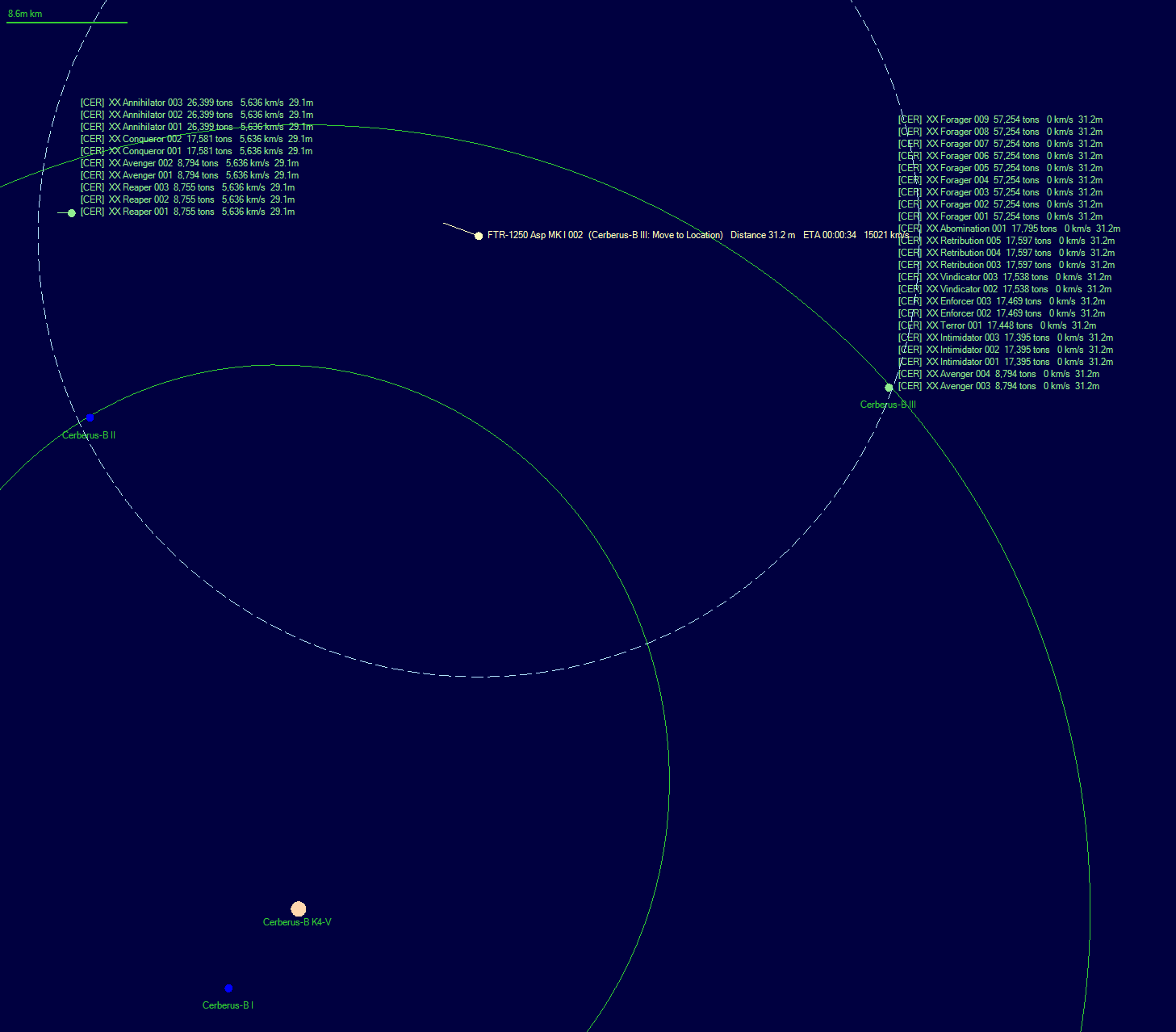
Commander Medea recalled the first Asp, which was low on fuel, and ordered the second Asp to pull back and try to lead the smaller fleet toward the Expeditionary Force. All four Battlestars shut down their active sensors to avoid detection until the alien fleet was too close to escape. Given the scale of the alien forces in the system, Medea hoped to fight the two alien fleet separately and defeat them in detail. The attempt to ‘hide’ the Battlestars proved unsuccessful as a Cerberus Watcher class scout was detected closing on their position. Viper Squadron 55 “Black Eagles” was dispatched to intercept. The Watcher had a speed speed of 8487 km/s, which was faster than the Viper MK I, but Viper Squadron 55 was equipped with the Viper MK II with a maximum speed of 10,000 km/s. Even though the Expeditionary Force had been detected, the alien fleet continued to pursue the Asp, with a second Watcher moving in to shadow the Asp at close range.
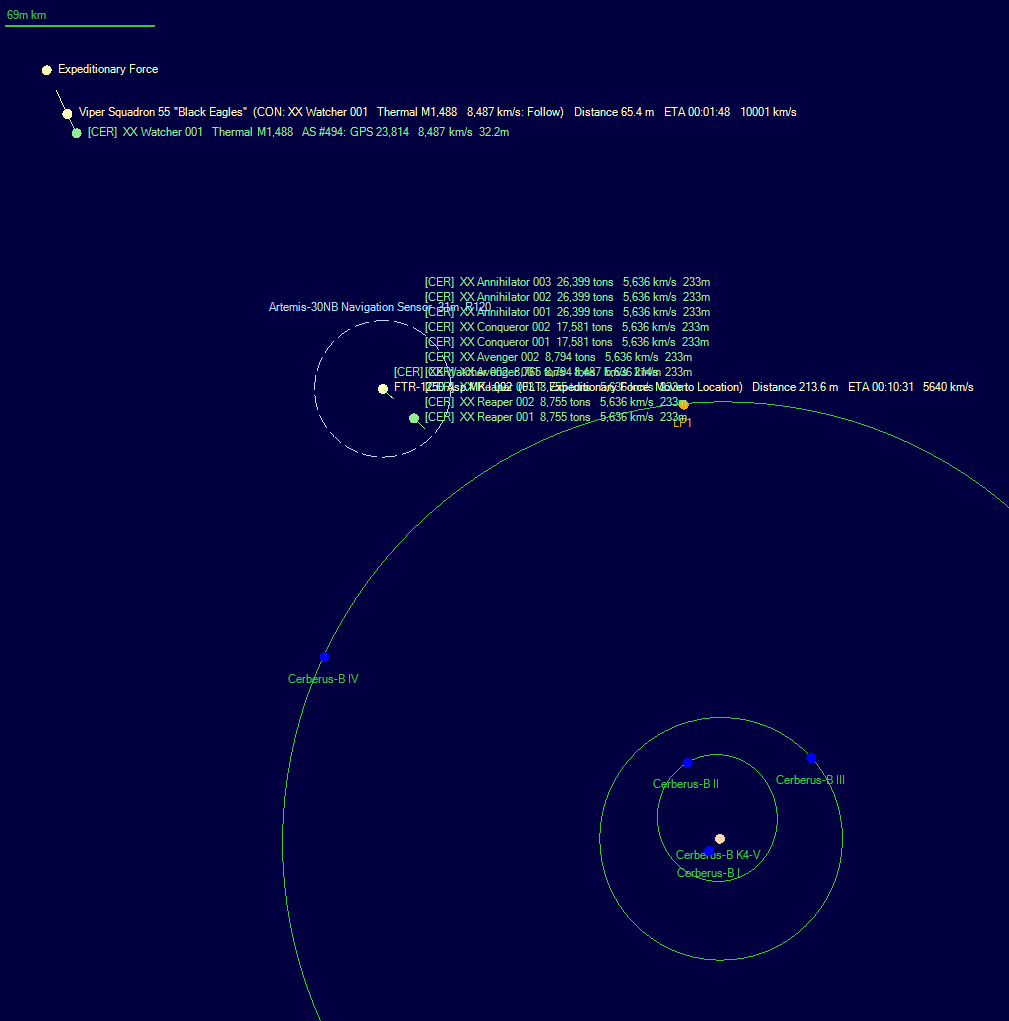
The Viper squadron intercepted the Watcher and destroyed it in three volleys then returned to refuel. As the alien ships were faster than the Battlestars, a ship-to-ship engagement would only be possible with their cooperation. Even if they did engage, their laser weapons were powerful and had the potential to inflict serious damage. Therefore Commander Medea decided to conduct a long-range strike. When the range from the Expeditionary Force to the approaching Cerberus fleet fell to two hundred million kilometres, the Battlestars launched all their fighters, comprising two hundred and forty Viper MK IIs and twenty Cobra MK IIs. The two Hermes class fighter transports launched their eight missile-armed Raptor-As.
The Raptors moved into range first and fired one hundred and forty-four Theseus missiles at the two Conqueror class ships. As the missiles approached, the Cerberus fleet turned perpendicular to its previous course. Eighty-three missiles were hit by energy-based point defence, which was concerning for the survival of Vipers in close combat. Thirty-four of the remaining missiles struck one of the Conquerors missiles with strength-4 warheads, seven of which penetrated armour. The damaged ship was reduced to 4231 km/s. The remaining ships reversed course and began to run. Sensor readings of the attack showed that the Conqueror was armed with seven gauss cannon turrets with eight shots per turret, making them extremely dangerous. The two ships of the previously encountered Avenger class had three gauss cannon turrets each. The inbound Viper squadrons were ordered to target the undamaged Conqueror and the two Avenger class escorts first.
The Cobra Squadrons were detached to deal with the damaged Conqueror while the Viper squadrons moved past the main body and then turn to engage head on. In response, the aliens reversed course away from the inner system and continued to run. Commander Medea ordered the fighters to hold the range open and shadow the aliens while his four Battlestars advanced in an effort to force the alien ships back toward his fighters. A head-on approach would result in fewer fighter losses than a stern chase.
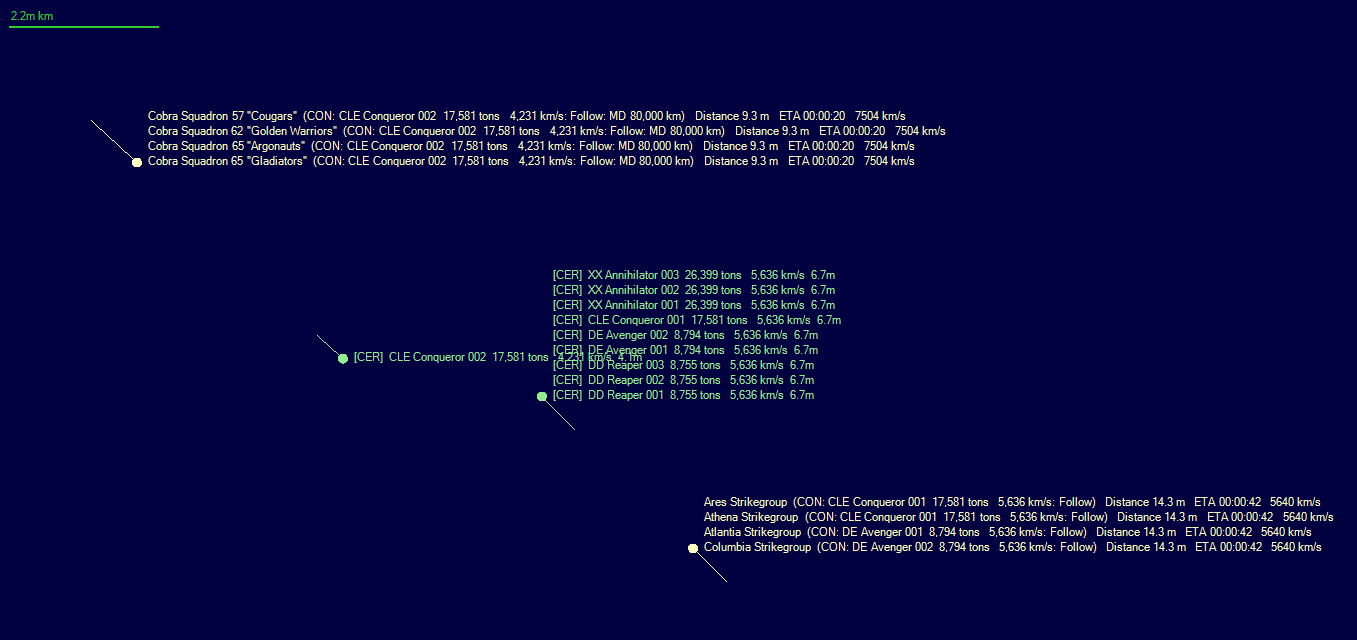
As the main body fled from the fighters, running toward the distant Battlestars, the twenty Cobra MK Is closed on the Conqueror damaged by the missile attack. Their particle beam armament was intended for this exact situation, attacking a hostile escort class from outside its weapon range. They held a relative position at 80,000 km and opened fire. Six volleys later, the Conqueror was wreckage. The Cobras headed back to the Battlestars, as Medea did not want to lose them in combat against ships that out-ranged them. The Cerberus main body continued running from the Vipers and did not seem deterred by the approaching Battlestars, which were advertising their presence with active sensors.
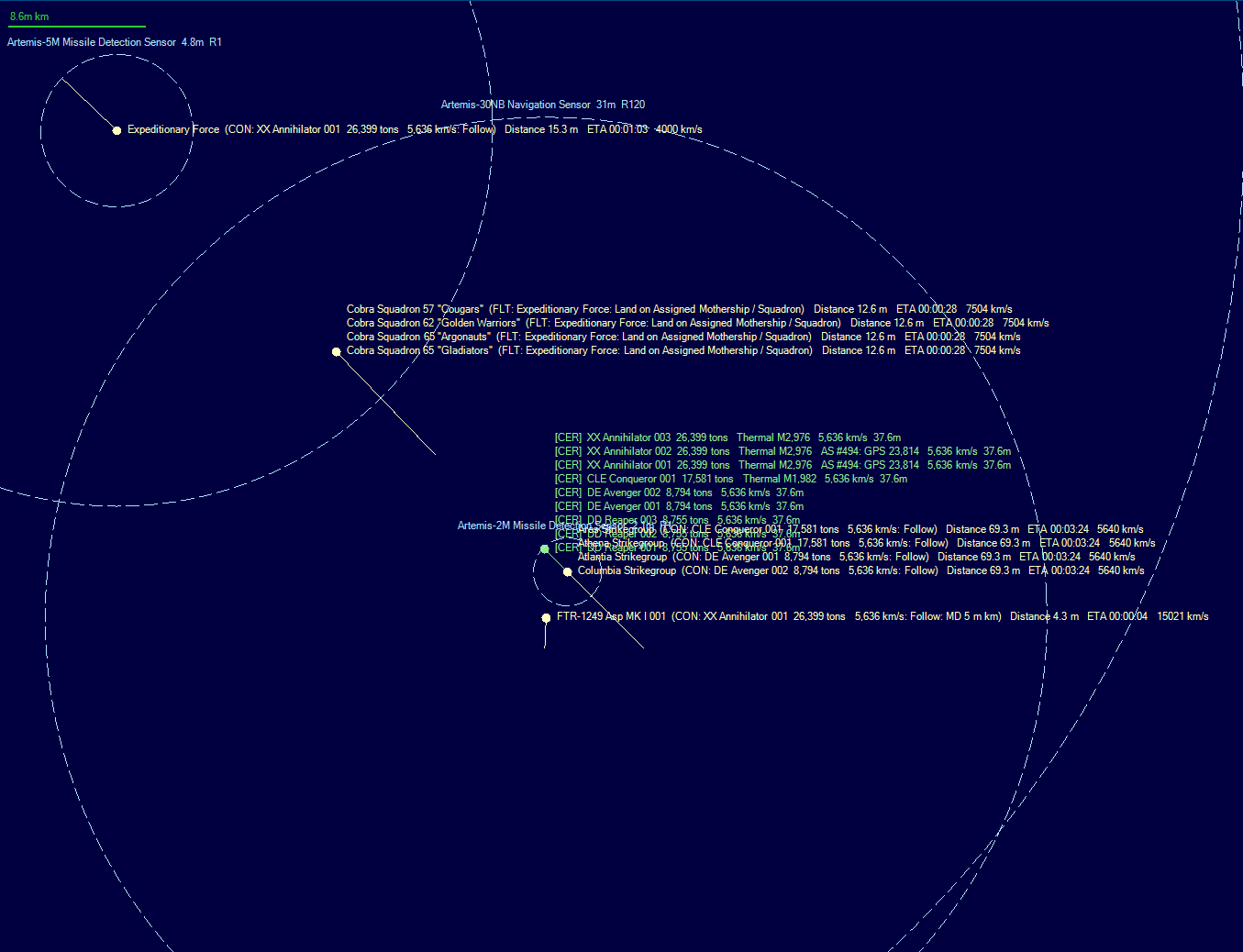
While Commander Medea was using his Battlestars in an attempt to reverse the course of the alien warships, he wished to avoid a major ship to ship engagement. The three 8800-ton Reapers were known to be armed with five powerful lasers and the Annihilator class was three times as large. It was possible the alien fleet might have sixty lasers or more, which would cause serious damage even to a Galactica class Battlestar. Therefore, with reluctance, he gave the order for the Viper Squadrons to close and attack. They moved in from astern, with a 4365 km/s speed advantage.
The first Cerberus defensive fire was at 318,000 km from their targets, far outside the 40,000 kilometre weapon range of the Vipers. The Annihilators proved to be very powerful energy combatants, armed with nineteen of the same 25cm lasers as the Reapers, plus a single 37.5cm laser. Fortunately, none of the seventy-five laser shots hit their fast-moving targets. The Cerberus aliens fired again at 231,000 km, this time killing five Vipers, every one of which suffered a secondary explosion. Suddenly, the nine alien ships reversed course and headed straight for the Vipers. The Vipers charged in at full speed, trying to get to point blank range. There was a sudden and intensely violent exchange of fire, with more than five hundred energy impacts registering within a few seconds. Seven Vipers were hit and destroyed by the gauss cannon of the Conqueror and two Avengers, but one of the Avengers was destroyed in response. The lasers of the Annihilators and Reapers were still recharging.
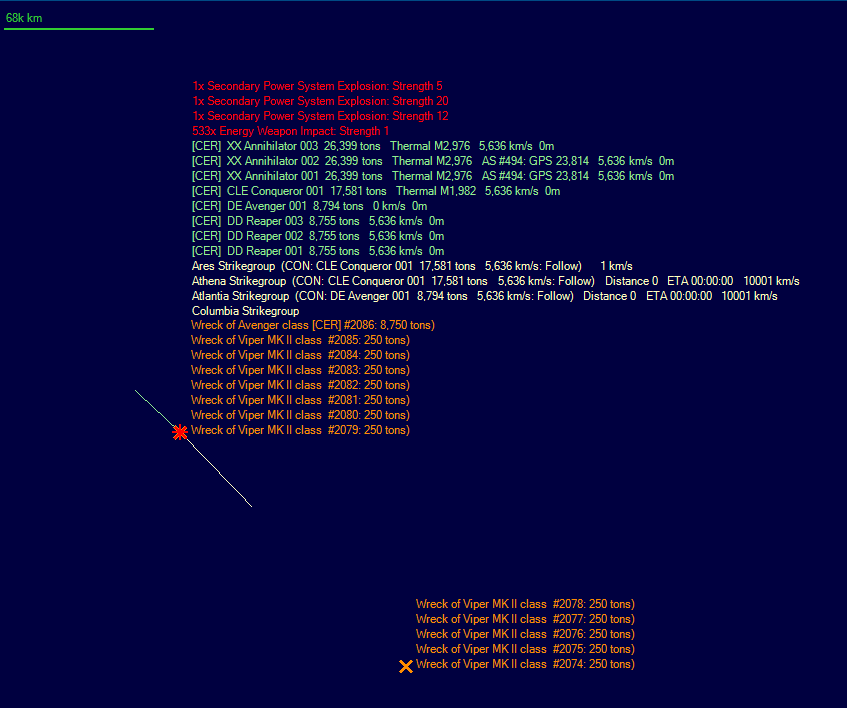
The Conqueror and surviving Avenger fired again and were joined by the rest of the fleet. Eleven more Vipers died, but their massed fire obliterated both escort warships. Each of the three Annihilators was then targeted by a full strikegroup of four squadrons, totalling sixty Viper MK IIs, while the Ares Strikegroup, which had taken all of the losses so far, went after the Reapers. Fifteen seconds after the targeting change, the depleted Ares strikegroup destroyed a Reaper, while the Columbia strikegroup had inflicted enough damage on an Annihilator to slow it down and force it out of the fleet. The alien weapons recharged and fired again, destroying five Vipers, but the aliens were now in serious trouble. Two Annihilators exploded, followed ten seconds later by the third. The remaining two Reapers lasted another five seconds.
The heroic Viper pilots had obliterated almost double their own tonnage in less than a minute in a battle against a higher tech opponent while losing only twenty-eight fighters, approximately twelve percent of their number. In comparison, the cost of the missiles that damaged a single Conqueror earlier in the battle was equal to ten Viper MK IIs. All the Cobra and Viper fighters returned to the Battlestars, which remained on station, ready to cover salvage operations, while the two fighter transports headed back to Sol.
In late October, the two Hermes class fighter transports returned from Sol with twenty-eight Viper MK II-Bs, a slightly upgraded version of the MK II with improved sensors and greater range, that would make up the losses of the expeditionary force. By this point, salvaging of the wrecks in the system, including the Jormungandr, was well underway, with all four Colonial salvage ship involved. An Asp was dispatched on a scouting run into the inner system of the B component and found the same ships in orbit as before.
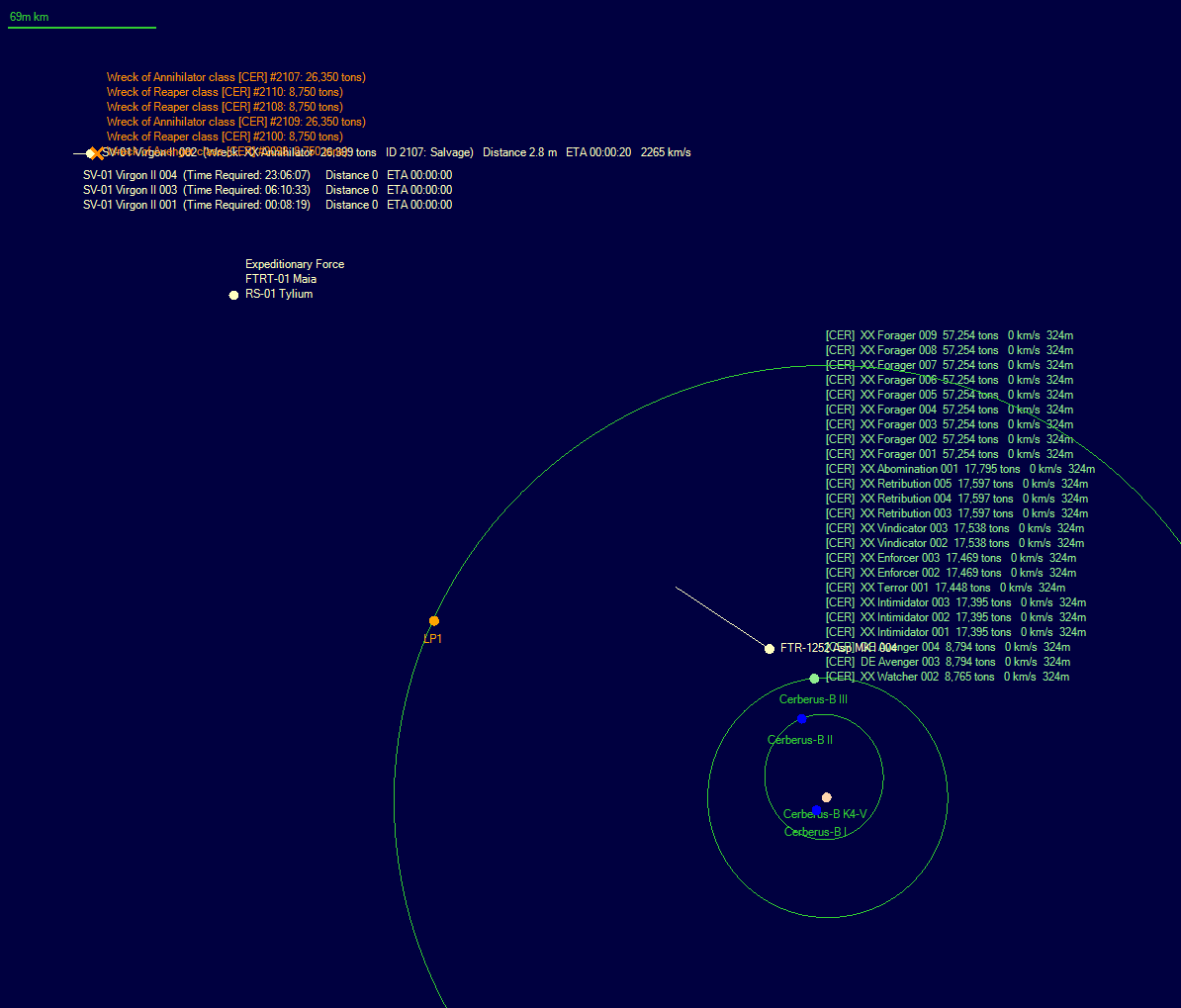
On November 11th 2308, a troop transport carrying two Xenoarchaeological expeditions transited into Pericles, a binary system with five planets that was discovered in June 2306. A geological survey had revealed little in the way of usable mineral deposits but discovered a destroyed alien outpost that was the destination of the transport. The system was four transits from Earth via Leonis, Ariadne and Cepheus and lay in a chain of six unremarkable system beyond the seldom-used Leonis – Ariadne jump point. As the transport transited into Pericles, it detected three alien ships of an unknown race stationed on the jump point. The largest was a Tribune class of 73,000 tons that was equipped with commercial engines, possibly a stabilisation ship. It was escorted by two military vessels: an Aquila class of 12,873 tons and a Corvus class of 6,446 tons. The aliens hailed the transport and seemed willing to attempt communications.
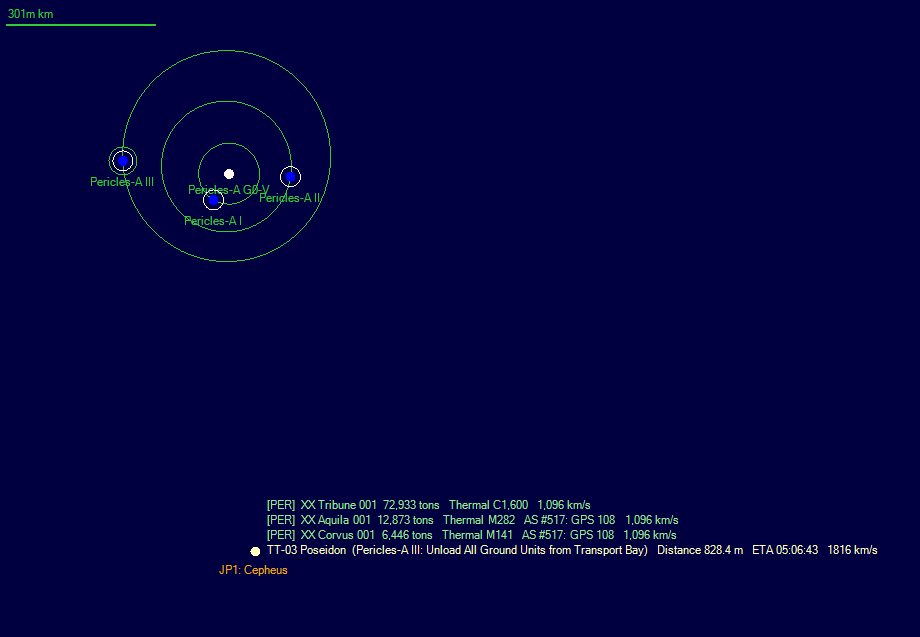
The Twelve Colonies had now encountered seven alien races, four of which had proved hostile. The hostiles included the Stave Commonality, which had laid claim to Sol, the Cerberus, which attacked any ship that entered their territory but did not seem to venture out of those systems, the Raiders, which had been encountered in the early years of interstellar exploration, and the Talosians, which initially resisted the well-intentioned attempts of the Twelve Colonies to protect them from aliens. The neutral races included the Church of Khazhar, which claimed territory beyond the Circe – Leoben jump point, the Kogari Dominion, which claimed territory beyond the Pandora – Archimedes jump point and now the new aliens in Pericles.
A jump tender transited into Pericles to continue communications attempts with the new aliens, allowing the troop transport to move to the site of the destroyed alien outpost on Pericles-A III. It detected a large alien force in orbit, comprising four 77,229-ton Senator class ships, along with six more Aquilas, two more Corvus and a small 4000-ton Consul class, plus a ground forces signature on the planet. It appeared the aliens were also interested in the destroyed outpost.
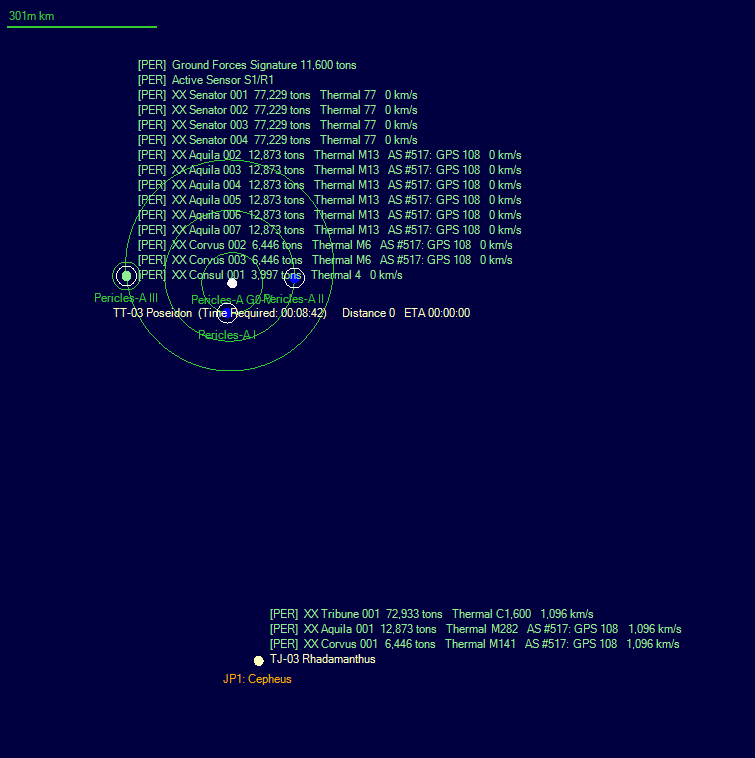
Two weeks after first contact with the Pericles aliens, the Battlestar Asgard was launched, the first in a new class constructed in the Picon Fleet Shipyard, which had previously built the Valkyrie II. The Asgard was twenty-five percent larger than the preceding Valkyrie II class, with hangar space increased in line with hull space. The class was armed with eight newly-developed 25cm railguns with a 250,000 km range, replacing the four 20cm railguns with a 160,000 km range on the Valkyrie, while retaining the pair of G20-8 Gauss Cannon Turrets. Armour was increased by forty percent and the sensors, based on recently improved technology, were superior to the larger Galactica class.
The range and endurance were reduced to twelve months deployment and two years maintenance life, in line with the Asgard’s intended role as a pure warship, rather than the hybrid role of the Valkyrie. The strikegroup retained the two Viper squadrons and two assault transports of the later Valkyries and gained six Cobras and two Asps in exchange for the single Raptor-S of the older design. The Asgard mounted eight box launchers for sensor drones in order to preserve the Asps for more critical scouting missions. The Battlestar Asgard was dispatched to Cerberus, along with the Galactica class Battlestar Solaris, to reinforce the Expeditionary Force. With a new alien race on the scene, the Council of Twelve was eager to resolve the situation in that system and secure the Cerberus planet.
Asgard class Battlestar 46,875 tons 963 Crew 6,383.6 BP TCS 937 TH 3,750 EM 0
4000 km/s Armour 6-115 Shields 0-0 HTK 246 Sensors 12/16/0/0 DCR 34 PPV 101.44
Maint Life 2.05 Years MSP 2,898 AFR 517% IFR 7.2% 1YR 918 5YR 13,773 Max Repair 375 MSP
Hangar Deck Capacity 15,000 tons Magazine 32 Cryogenic Berths 400
Colonel Control Rating 3 BRG AUX ENG
Intended Deployment Time: 12 months Flight Crew Berths 300 Morale Check Required
Zeus Drive Systems ZDS-750 Ion Drive (5) Power 3750 Fuel Use 24.49% Signature 750 Explosion 10%
Fuel Capacity 1,538,000 Litres Range 24.1 billion km (69 days at full power)
Ares Kinetics AK-25 Railgun (8x4) Range 250,000km TS: 4,000 km/s Power 15-3.75 ROF 20
Ares Kinetics G20-8 Gauss Cannon Turret (2x8) Range 20,000km TS: 16000 km/s RM 20,000 km ROF 5
Hyperion R256-S4 Beam Fire Control (2) Max Range: 256,000 km TS: 4,000 km/s
Hyperion R64-S16 Beam Fire Control (1) Max Range: 64,000 km TS: 16,000 km/s
R-15 Stellarator Fusion Reactor (2) Total Power Output 30.9 Exp 5%
Missile Box Launcher (

Missile Size: 4 Hangar Reload 100 minutes MF Reload 16 hours
Graystone GFC-25 Missile Fire Control (1) Range 25.9m km Resolution 120
Active Sensor Drone (4) Speed: 6,250 km/s End: 6.9d Range: 3,750m km WH: 0 Size: 4 TH: 20/12/6
Passive Sensor Drone (4) Speed: 6,250 km/s End: 6.9d Range: 3,750m km WH: 0 Size: 4 TH: 20/12/6
Artemis-80B Active Sensor (1) GPS 13440 Range 83.3m km Resolution 120
Artemis-6MB Missile Detection Sensor (1) GPS 16 Range 6.4m km MCR 574.5k km Resolution 1
Themis EM-16B Passive Sensor (1) Sensitivity 16 Detect Sig Strength 1000: 31.6m km
Themis TH-12 Passive Sensor (1) Sensitivity 12 Detect Sig Strength 1000: 27.4m km
Strike Group
30x Viper MK II Fighter Speed: 10001 km/s Size: 6
6x Cobra MK II Fighter Speed: 7504 km/s Size: 11.99
2x Raptor-MB Assault Transport Speed: 8754 km/s Size: 19.99
2x Asp MK I Fighter Speed: 15021 km/s Size: 3.99
The Battlestars Solaris and Asgard joined the Expeditionary Force in Cerberus on January 7th. The entire force set course for Cerberus-B III where a second alien fleet awaited them.
Expeditionary ForceGalactica II class Battlestar:
Ares, Athena, Atlantia, Columbia, SolarisAsgard class Battlestar:
Asgard12x Raptor-MB class Assault Transport:
2x Raptor-SB class Scout
3x Raptor-SC class Scout
31x Cobra MK II class Fighter
30x Viper MK I class Fighter
272x Viper MK II class Fighter
28x Viper MK II-B class Fighter
2x Asp MK I class Fighter
Forty-six million kilometres from the planet, an inbound wave of seventy-six size-4 missiles was detected. All the Battlestars launched their Vipers, which took up defensive positions around their motherships. Every missile was shot down by a combination of gauss cannon, Viper cannon and railguns. Five further waves arrived at intervals of four minutes and met the same fate as the first. At fourteen million kilometres, a new attack was detected, this time from a wave of sixty-three missiles that comprised seven salvos of nine missiles each. Once again, all were shot down by the Battlestars and their Viper escort. Another wave of seventy-six in a single salvo arrived shortly afterwards, still without any success. The identity of the ship launching the large missile waves was unknown, but given the size of the waves and the long interval between them, it appeared to be a ship armed with slow-firing but compact launchers, allowing large but infrequent salvos.
At six point four million kilometres, seven new ships of 979 tons, designated as Punisher class, were detected. They seemed to be a likely candidate for the wave of missiles that included seven separate salvos, which indicated a similar design to the Raptor-A missile corvette. A ground forces signature of 45,000 tons was also detected, which suggested a much larger force given it was likely to be fortified.
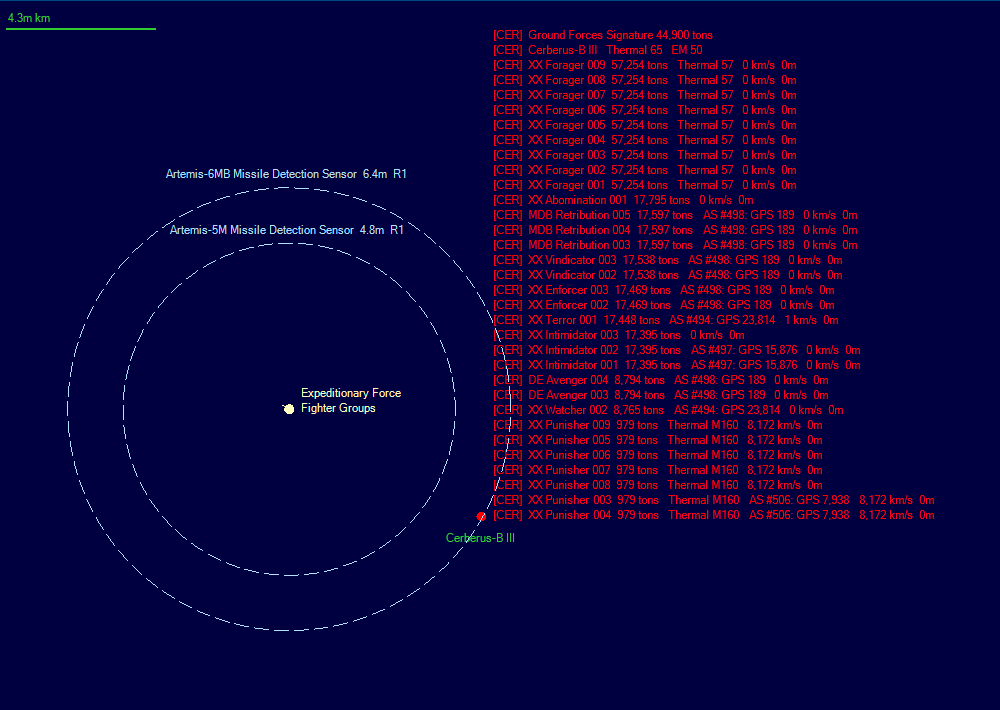
When the Expeditionary Force moved within two point five million kilometres of Cerberus-B III, an inbound wave of two hundred and sixty-five size-1 missiles was detected moving at almost 70,000 km/s, followed by a second wave a few seconds behind and another wave of seventy-six larger missiles. Commander Medea immediately gave the order to reverse course and retreat.
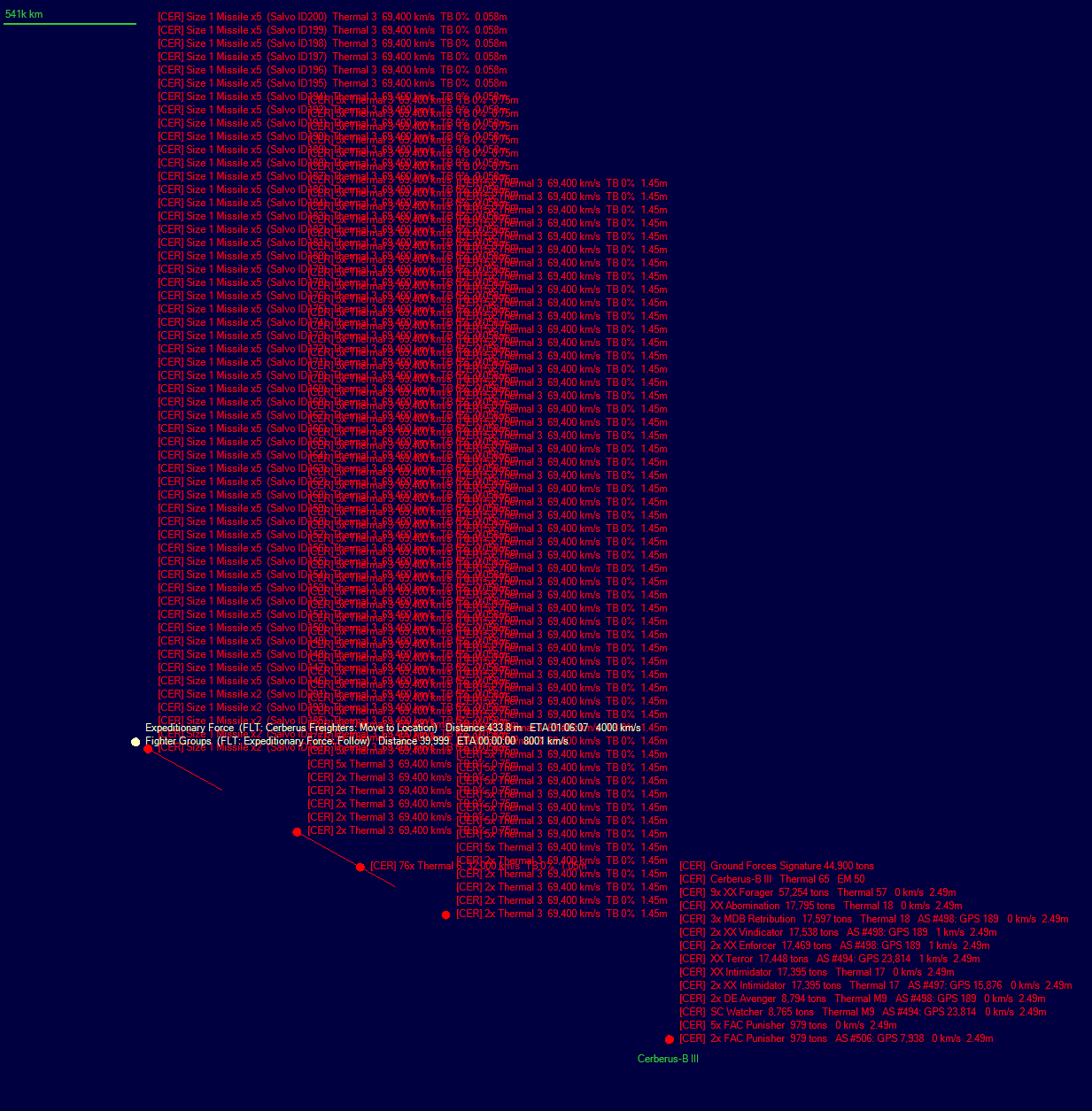
The Battlestars and the massed Viper squadrons destroyed one hundred and twenty-four missiles. The Battlestar Ares was struck by the other one hundred and forty-one. The subsequent wave inflicted even more damage as the railguns recharged. Ares suffered one hundred and sixty hits from the second wave and one hundred and seventy-three from the third, badly damaging her formidable armour. Fortunately, the lone seventy-six missile salvo arrived between waves of the faster missiles and did not penetrate the Colonial defences.
Unfortunately, a momentary lack of coordination between the Battlestars and their strikegroups placed them twenty thousand kilometres apart as a fourth wave of size-1 missiles arrived. The Battlestar Ares received one hundred and eighty-nine hits, four of which penetrated her armour and damaged her hangar bays. A fifth wave followed close behind, but was targeted on the Battlestar Athena. One hundred and sixty-four hits only scarred her armour compared to the devastation that would have been inflicted on Ares. Fortunately, that was the last wave. Commander Medea’s swift decision to reverse course had apparently allowed the Expeditionary Force to move out of range of the smaller missiles before a sixth wave could be launched.
The Expeditionary Force retreated to Sagittaron, where the Battlestars Columbia and Solaris were assigned to guard the colony. Two Ragnar class space stations in orbit and twenty-eight maintenance facilities on the surface provided enough maintenance capacity to support two Galactica class Battlestars. The rest of the fleet returned to Sol for repairs and overhauls. Until the size of the Colonial Fleet could be expanded, the assault on Cerberus-B III would have to be postponed.
In mid-January, full communications were established with the Federated States of Remus, the alien race that had been encountered in the Pericles system. Both sides were keen to establish diplomatic relations so an Armistice class diplomatic station was towed to the system. The Remus were a race, like the Khazhari, who seemed to be very closely-related to humanity in terms of appearance. In fact, the only immediately identifiable differences were pointed ears and more angular features. Unlike the Khazhari, the Remus had a spartan approach in their sartorial choices, wearing simple unforms of red and silver, and their conduct seemed efficient and competent, yet courteous.
The Council of Twelve wanted to repeat the success of the colonization efforts in Pandora and Talos in terms of securing the systems against alien claims, so the shipping capacity of the Twelve Colonies was devoted to building up a new colony on Pericles III. The ruins on the planet were fully surveyed in March 2309 and eleven potential sites of interest were identified. The Federated States also finished their own survey and the recovery operations became a race between the two sets of ground forces. Fuel, supplies, infrastructure and a mining complex were recovered by Colonial engineers.
Two more Asgard class Battlestars, Midgard and Vanaheim, joined the Colonial Fleet in late March. The total Battlestar strength was now ten Galactica II class, nine Valkyrie II class and three Asgards.
In May 2309, the attention of the Council was drawn to the Tauron Chain, which started with Aeolus, the point of contact with the Stave Commonality, then continued into Tauron, site of a Colonial population, and a further twenty-five systems beyond. It was the most isolated part of known space with none of the cross-connections found in the chains beyond Sol’s other jump points. The main system of interest in the area beyond Tauron was Sparta, six transits further out, which was a vast trinary with five potential colony worlds.
The system primary was a G-5 IV sub-giant with four planets and twenty-nine moons. The fourth moon of Sparta-A I was similar in size to Io and had four million tons of accessibility 0.7 Duranium and large accessible deposits of Boronide, Corundium and Gallicite. The moon lacked air and water but the temperature was -30C and it was small enough to make terraforming a realistic prospect. The ninth moon of the same superjovian was a Mars-sized world with liquid oceans, a thin nitrogen-oxygen atmosphere and a dormant alien construct on the surface. The fifth moon of Sparta-A II was Mercury-sized world with ten million tons of accessibility 0.9 Duranium and large accessible deposits of Neutronium, Mercassium and Vendarite. The atmosphere of 0.24 atm included 0.07 atm of oxygen and ice sheets covered half the surface. The temperature was low at -123C but it was another reasonable terraforming project.
Sparta-A I - Moon 4 Survey ReportDuranium: 4,274,888 0.70
Corbomite: 534,361 0.30
Tritanium: 2,663,424 0.30
Boronide: 1,803,649 1.00
Corundium: 374,544 0.80
Gallicite: 534,361 0.90
Sparta-A II - Moon 5 Survey ReportDuranium: 10,396,800 0.90
Neutronium: 4,260,096 0.50
Tritanium: 3,326,976 0.10
Boronide: 627,264 0.10
Mercassium: 968,256 0.60
Vendarite: 451,584 0.80
Gallicite: 5,184 0.60
Two of the five planets orbiting Sparta-B had breathable atmospheres and large ice sheets, with colony costs of 0.49 and 0.78 respectively. Sparta-B II had deposits of all eleven minerals, with a range of accessibilities, while Sparta-B III had fifty-six million tons of accessibility 1.0 Duranium. The latter was Earth-sized, while the former was midway between Mars and Earth in size. Both were tide-locked and had orbits of minimal eccentricity. Sparta-B, an M3-V red dwarf, orbited twenty-seven billion kilometres from the primary, but a stabilisation ship had made the long journey to the star and stabilised the LaGrange point of Sparta-B IV.
Sparta-B II Survey ReportDuranium: 10,179,072 0.30
Neutronium: 8,219,689 0.50
Corbomite: 565,504 0.10
Tritanium: 6,682,225 0.60
Boronide: 14,853,316 1.00
Mercassium: 883,600 0.70
Vendarite: 3,359,889 0.80
Sorium: 3,534,400 0.50
Uridium: 14,853,316 0.10
Corundium: 3,896,676 0.10
Gallicite: 715,716 0.10
Sparta-B III Survey ReportDuranium: 56,010,528 1.00
Mercassium: 33,593,616 0.10
Vendarite: 9,922,500 0.10
Sorium: 28,005,264 0.10
Gallicite: 17,816,841 0.10
The downside to Sparta was its distance from Sol, requiring a forty-two billion kilometres round trip for freighters and colony ships. A single outward jump point led to the Orpheus system, a red dwarf binary, so the Battlestar Valkyrie and the Loki II class Support Vessel Freya were operating in Sparta, sending Raptors into Orpheus and the systems beyond in search of a faster route to Sol. In late May, a Raptor-G was attacked by an unknown assailant close to the inner of two planets orbiting Orpheus-B, after successfully completing a geological survey of the primary solar system. A new Raptor-SC, equipped with the Artemis-60B active sensor, was sent all the way from Earth to investigate. On June 12th 2309, it detected six Cerberus ships in orbit of Orpheus-B I. This was a much smaller fleet than the armada in Cerberus, comprising six ships of different classes, split equally between 17,500 tons and 8,800 tons. Given the distance from Sol, this Cerberus force would be avoided in the short-term rather than confronted.
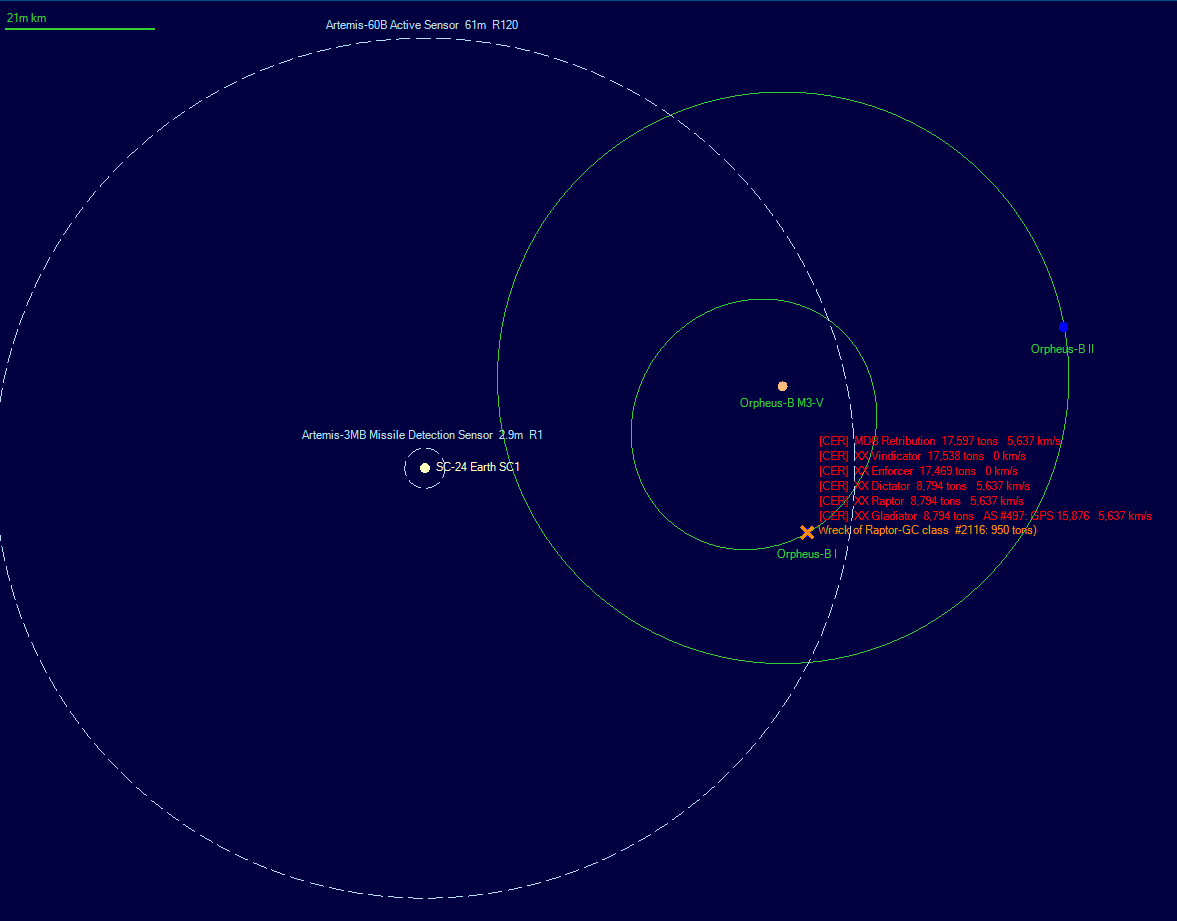
By September 2309, five different mineral deposits had been exhausted on Earth and two more had accessibilities below 0.2. Fortunately, several of the off-world colonies had substantial mineral deposits and a program was underway to transfer mining capacity. This had been slowed greatly by the need to build up colonies in Pandora, Talos and more recently Pericles, but it would soon become the primary mission of Logistics Command. The state of the major colonies on September 4th 2309 is shown below. At this point, Earth still retained thirteen hundred mining complexes.
MarsPopulation: 12.4m
Installations: 313x Automated Mine, 138x Mine.
Duranium: 723,777 0.80
Tritanium: 1,037,236 0.10
Vendarite: 5,661,236 0.10
Sorium: 2,134,280 0.10
Gallicite: 1,015,089 0.80
TrinculoInstallations: 28x Automated Mine.
Duranium: 11,568 1.00
Neutronium: 6,722 1.00
Corbomite: 1,349 0.69
Tritanium: 4,687 1.00
Boronide: 4,687 1.00
Leonis Colony Location: Adjacent to Sol
Population: 18.2m
Installations: 199x Mine, 6x Maintenance Facility, 1x Refuelling Station
Duranium: 552,225 0.90
Neutronium: 177,453 0.70
Tritanium: 153,617 0.60
Boronide: 482,553 0.70
Sorium: 131,581 0.50
Corundium: 630,425 0.90
Gallicite: 386,261 1.00
Talos Prime Location: Two transits via Circe
Population: 6.6m (also 888m Talosians)
Installations: 87x Mine, 4x Maintenance Facility
Duranium: 1,163,480 1.00
Neutronium: 202,392 0.90
Corbomite: 260,480 1.00
Tritanium: 526,916 0.70
Boronide: 218,216 0.70
Mercassium: 461,480 1.00
Vendarite: 439,916 0.70
Sorium: 1,182,378 0.60
Uridium: 241,052 0.40
Corundium: 234,340 0.50
Gallicite: 297,228 0.60
Scorpia ColonyLocation: Two transits via Circe
Population: 5.3m
Installations: 7x Maintenance Facility, 1x Refuelling Station, 1x Ragnar class space station
Duranium: 134,162 0.90
Corbomite: 998,001 0.10
Tritanium: 9,431,041 0.10
Boronide: 443,556 0.10
Vendarite: 7,295,401 0.20
Sorium: 3,422,500 0.10
Uridium: 5,784,025 0.80
Pandora ColonyLocation: Three transits via Circe and Talos
Population: 4.8m
Installations: 1x Ragnar class space station, 1x Fighter Base class space station
No Mineral Deposits
Pericles ColonyLocation: Four transits via Leonis, Ariadne and Cepheus
Population: 3.4m
Installations: 1x Mine
No Mineral Deposits
Sagittaron ColonyLocation: Three transits via Leonis and Carthage
Population: 3.0m
Installations: 13x Mine, 28x Maintenance Facility, 1x Refuelling Station, 2x Ragnar class space station
Duranium: 145,767 0.90
Neutronium: 1,920,981 0.40
Corbomite: 2,232,018 0.50
Tritanium: 876,081 0.40
Mercassium: 142,869 0.40
Vendarite: 1,166,389 0.30
Sorium: 352,807 0.80
Uridium: 15,850 0.70
Corundium: 1,454,414 0.60
Gallicite: 2,073,571 0.80
Tauron ColonyLocation: Two transits via Aeolus
Population: 2.0m
Installations: 29x Mine, 2x Automated Mine, 5x Maintenance Facility, 1x Refuelling Station
Duranium: 1,877,571 1.00
Neutronium: 1,214,088 0.90
Tritanium: 60,658 1.00
Uridium: 3,326,730 0.70
Corundium: 1,718,651 0.20
Aquaria ColonyLocation: Three transits via Proxima and Typhon
Population: 2.0m
Installations: 5x Mine, 1x Automated Mine
Duranium: 11,290,717 0.50
Neutronium: 8,928,075 1.00
Corbomite: 11,209,097 0.10
Tritanium: 5,645,369 0.10
Boronide: 3,779,129 0.10
Mercassium: 3,239,931 1.00
Vendarite: 4,822,374 0.60
Sorium: 1,774,217 0.10
Uridium: 876,089 0.10
Corundium: 11,943,894 0.60
Gallicite: 11,209,097 0.10
Typhon Comet Mining ColonyLocation: Two transits via Proxima
Installations: 140x Orbital Mining Module
Duranium: 137,684 0.90
Neutronium: 14,518 0.90
Corbomite: 149,711 1.00
Sorium: 74,281 0.50
Uridium: 54,541 0.70
Gallicite: 77,401 0.90
Terraforming had been performed on several of the colonies, with the Leonis Colony and Talos Prime both ideal habitable worlds. Sagittaron Colony had a breathable atmosphere and a temperature of 10C, but water coverage was less than ten percent. The colony cost of 1.02 was slowly reducing as water vapour was added to the atmosphere. Tauron Colony also had a breathable atmosphere, but the temperature situation was more complex due to a seventy-eight degree range across its orbit. It was also in the process of condensing surface water. Scorpia colony had plenty of surface water and a temperature within human tolerance. As soon as the percentage of oxygen in the atmosphere fell below thirty percent, which was close at hand, it would become an ideal habitable world.
With the Pericles colony at a population of three point four million, the Council of Twelve instructed Colonial diplomats to inform their counterparts from the Federated States of Remus that the Twelve Colonies was formally claiming the Pericles system. The Federated States rejected the claim, stating that the system was important to them and that they would defend it. The two systems between Pericles and the Leonis Colony, adjacent to Sol, were both planetless red dwarves, so there was no other real estate that could be claimed. The Council of Twelve, in conjunction with the Colonial Fleet, had to either press the claim on Pericles militarily, or accept eventual Remus activity much closer to Earth.
